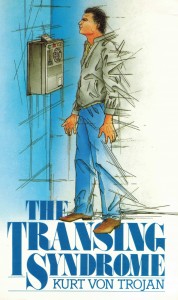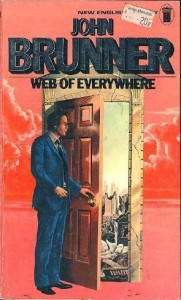The Power of Names
The world’s first matter transmitter story was published in 1877. It was written by an amazing guy, Edward Page Mitchell, who was also the first to write about time machines, intelligent computers, cryogenics, mutants, cyborgs, and invisibility, beating not just H. G. Wells to at least two of those tropes but everyone else as well. By a very large margin.
In “The Man without a Body” he postulates a machine that can transmit physical objects, including people, through wires from one side of the Atlantic to the other, just like the telegraph. He called it the Telepomp. That was the first name ever given to a machine of this nature. There had been magical devices in the past: just the year before, the premiere of Richard Wagner’s epic opera Götterdämerung had featured the Tarnhelm, a magical hat that could take the wearer anywhere as well as change their physical form. The Tarnhelm was made by dwarfs; the Telepomp was invented by a scientist. The difference between them was profound.
Mitchell singlehandedly created a trope and with it a style of story made famous exactly 80 years later when “The Fly” was published. Ask not what d-mat can do when it works; gape in horror at what happens when it fails. Even separated by almost a century, the structure of the two stories are spookily similar, which speaks to the power of the narrative that Mitchell first played with.
Anyway . . . Telepomp. Not the catchiest of names. I have a theory that one of the reasons the time machine trumps d-mat as an object of fascination and study is that it does have a catchy name. Mitchell might have got to the idea first, but H. G. Wells sealed the deal. It pains me to think that my favorite trope has been overlooked because we don’t know what to call it yet, but there you have it. Maybe it’s still too big a thing to pin down in a single word. Or maybe the somewhat lackluster but persistent trifecta of teleporter / transporter / matter transmitter are what we’re stuck with–not one name encompassing the all of it, but three that can be used almost interchangeably.


(These graphs show the appearance of various terms from books published in English, thanks to Google’s Ngrams. The term “matter transmitter” was coined in 1931 but doesn’t show up in earnest until the mid 1940s. “Transporter” swamps the rest of the data because of mundane use, and the same with “jaunt”, so I’ve included neither of them here. “Teleport”, first used in 1944, is the big winner, on a steady rise from the 1960s, even more popular than “TARDIS”, which I’ve included because it’s a space machine as well as a time machine. Question: Why the big bump in the 1990s? All suggestions welcome.)
The need to name things is strong in science fiction and many, many writers have had a crack at this particular trope. Here are some of the more strange, clever, and amusing examples from the past, offered with love and enormous respect for those who trod this path long before I happened on it.
 cellular fragmentation & molecular dissemination (“Counter Plot”, Doctor Who, 1965)
cellular fragmentation & molecular dissemination (“Counter Plot”, Doctor Who, 1965)- Cosmic Express (Jack Williamson, “The Cosmic Express”, 1930)
- digital conveyor (GalaxyQuest, 1999)
- disintegrator-reintegrator (George Langelaan, “The Fly”, 1957)
- displacement booths (Larry Niven, “The Alibi Machine”, 1973)
- electroport (“Fun and Games”, The Outer Limits, 1964)
- etheric transmigration (Benjamin Witwer, “Radio Mates”. 1927)
- Farcaster (Dan Simmons, Hyperion, 1989)
- hyper-wavicle dissolution and resolution (Alan E. Nourse, “The Universe Between”, 1951)
- Instravel (Jack Wodhams, “There is a Crooked Man”, 1967)
- jumpdoors (Frank Herbert, Whipping Star, 1970)
- mattercaster (Poul Anderson, The Enemy Stars, 1959.)
- MOIRA: Matter, Organic and Inorganic Reconstruction Apparatus (George Collyn, “Mix-Up”, 1971)
- MT (Harry Harrison, One Step from Earth, 1970)
 passways (Jack Vance, “Rumfuddle”, 1973)
passways (Jack Vance, “Rumfuddle”, 1973)- posters (John Brunner, The Infinitive of Go, 1980)
- radio transporter (Arthur C. Clarke, “Travel by Wire!”, 1937.)
- skelters (John Brunner, Web of Everywhere, 1974)
- Steel Womb (Thomas M. Disch, Echo Round His Bones, 1966)
- stepping disks & transfer booths (Larry Niven, Ringworld, 1970)
- transmatter (Alan E. Nourse, “The Universe Between”, 1951)
- transplat (Theodore Sturgeon, “Granny Won’t Knit”, 1954)
- travel dials (“The Keys of Marinus”, Doctor Who, 1964)
- trip-box (Roger Zelazny, Eye of Cat, 1982)
- vibro-transference (Duncan H. Munro, “U-Turn”, 1950)
- Wonkavision (Roald Dahl, Charlie and the Chocolate Factory, 1964)
- X-cast (Norman Matson, Doctor Fogg, 1929)

Here from TWO other places (Scalzi, Kowal).
What a cool topic for a dissertation!
My guess about the big bump in “teleport” in the 90s: that’s around when telecommuting was becoming a big deal. I remember reading articles (I kind of think a lot of articles, but it’s been a while) that referred to teleporting as a comparison or as a joke.
Hey, you could be right. And maybe ST:TNG gave the term a bit of a bump, too. Can’t remember off the top of my head when that started, but it must’ve been around then. Thanks for the thought!